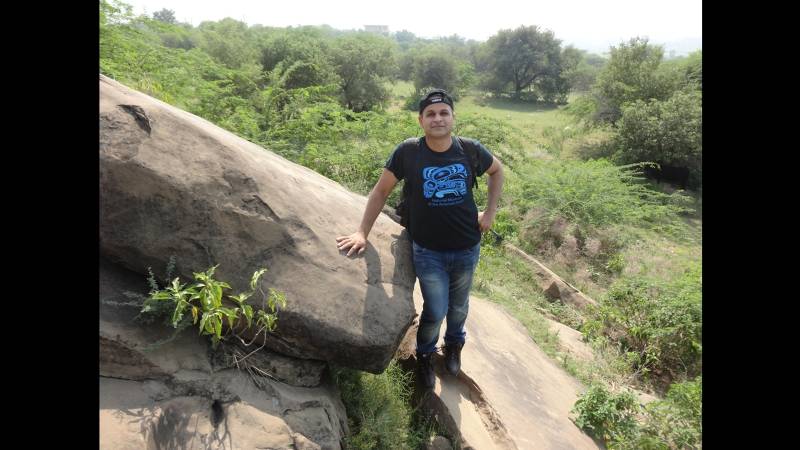
In 2008, I visited Chitter Pari for the first time as I was travelling to Mirpur City. A friend had told me about the rock carvings in Chitter Pari village while I was doing research on the cultural landscape in Punjab’s Pothohar. During my extensive exploration, I discovered numerous rock art sites in Pothohar, and it was during these discoveries that a friend informed me about the presence of petroglyphs in Azad Kashmir’s Chitter Pari village. Thus, on my way to Mirpur, I stopped at Chitter Pari to see the engraved rocks. It was a brief visit. Chitter Pari is located on Mangla-Mirpur Road and just opposite Mangala Dam. It is located about 4 km away from Mirpur city. I briefly visited the rock art site in Chitter Pari in 2008. Later, I revisited the site in 2009 and 2011 to study it thoroughly. I continued exploring the rock art landscapes of Azad Kashmir. I missed a few engraved boulders in my previous visits. These boulders were located south and southeast of Chitter Pari village. In order to document those engraved boulders, I revisited Chitter Pari again in 2015 with the help of my friend Imtiaz Ahmad. During this visit, his friends accompanied me to the Chitter Pari rock art site. My nephew, Javed Ali Kalhoro, was also with me during this trip.
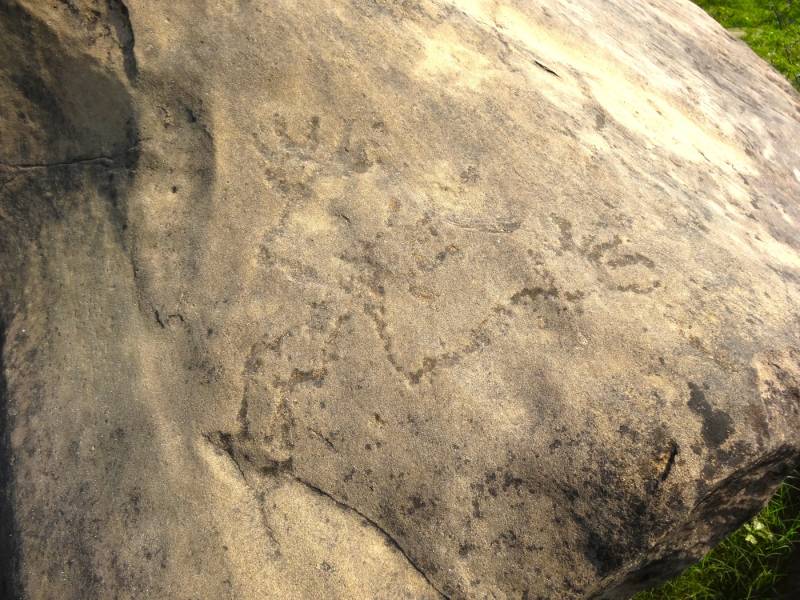
My extensive exploration of rock art sites in Azad Kashmir has led me to Chitter Pari, which stands out as one of the largest and most intriguing. The enigmatic cup-marks, or cupules, have always fascinated me, leading me to discover many cupule sites in other regions of Pakistan. My unique interest in investigating the ethnography of cup-marks is what sets my research apart, a perspective that many scholars have largely overlooked. I have brought this perspective to the forefront in my three research papers published in journals and edited books, including The Cup-marks in Gadap, Karachi, Cupules in Khirthar, Sindh and Rock Art of Islamabad.
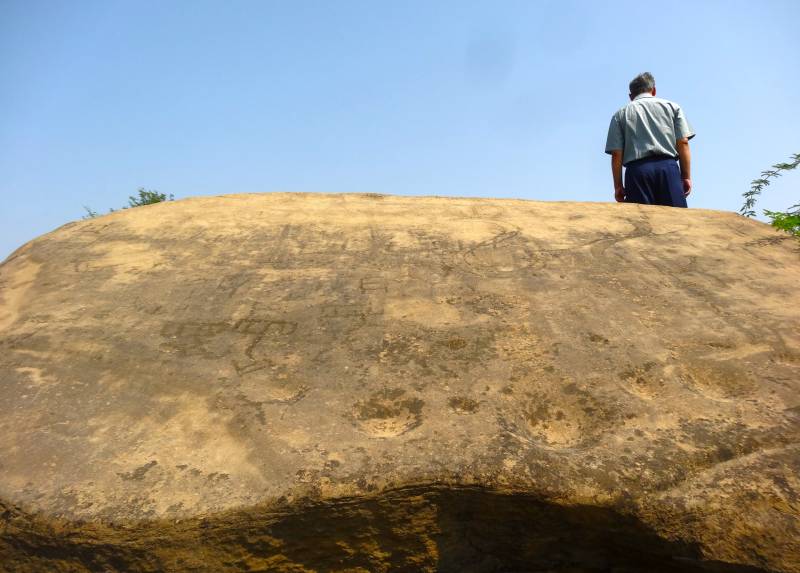
Now, let's delve into the unique features of the Chitter Pari rock art site. The village's name, Chitter Pari, is derived from the engraved rocks that it is known for. These rocks, located in the village, depict prehistoric and historic period petroglyphs. A few boulders, a short distance from the village, mainly depict cup marks. The most striking feature of the Chitter Pari rock art site is the concentration of the cup-marks. There are several boulders that depict these marks, most of which are made in double rows, possibly representing a game board or receptacle of some past rituals. The mystery of the rituals adds to the intrigue of the site. Dr Robert G Bednarik, the founding convener and editor of the Australian Rock Art Research Association (AURA), has written extensively on cupules, providing different interpretations of cup marks. His most seminal article, 'Cupules,' published in Rock Art Research in 2008, defines cupules or cup marks as, in most (but not all) cases, hemispherical depressions or holes in natural rock surfaces.
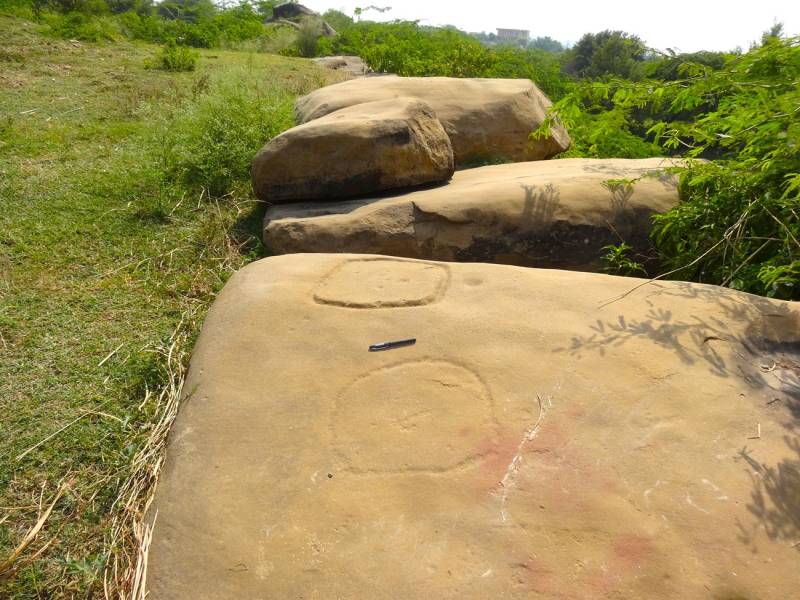
Cup-marks are found in other villages in Azad Kashmir. In fact, I have documented cup marks in Pakistan’s different regions. However, a large number of cup-mark sites are located in Sindh province. Cupules or cup-marks have also been discovered in the Swat Valley by Dr Luca Maria Olivieri and Dr Massimo Vidale, eminent Italian archaeologists. Cup-marks are also distributed in Punjab’s Pothohar plateau. From 1998 to 2023, I have documented more than 34 cupule sites in the Pothohar region only. They are numerous in the villages of Islamabad. The cup marks have always escaped the attention of national scholars.
One of the boulders at Chitter Pari bears the name of Tassaduq Abbas with the date 17-7-1991 enclosed in a heart-shaped design. On this boulder are found several ancient carvings. Most noticeable are two tower-like structures representing Buddhist stupas or temples
Not all cup-marks were used as game boards; those in double row seem to be used as game boards. It all depends on its position. If made on a vertical surface, their function may differ from those on a horizontal surface. It is possible that a few of those were used as communication among the shepherds. If one hits a stone against a cup-mark once, twice or thrice, it produces a different sound; this sound was understood by a distant fellow shepherd interpreting it that his fellow shepherd called him. This activity might have continued for various purposes among the Chitter Pari and neighbouring villages' shepherd communities in the past. My own research amongst the Shepherd community in Sindh and Pothohar shows that each of the animals’ bells sometimes produces different sounds. By that sound, the shepherd recognizes his animal and ensures that the animal is not gone far away. If it happens, he suddenly shouts at the animal, and his message is understood by the animal, whether a goat or cow. Interestingly, the number of bells on animals reflects the power amongst the shepherd community. The more bells, the more power a shepherd has in the herding community; this is one of the possibilities that the cup marks were used as a communicating device amongst the shepherd community, with each stroke hitting against the cup mark producing a different sound, thus drawing the attention of the fellow shepherds grazing his herds at a distance.
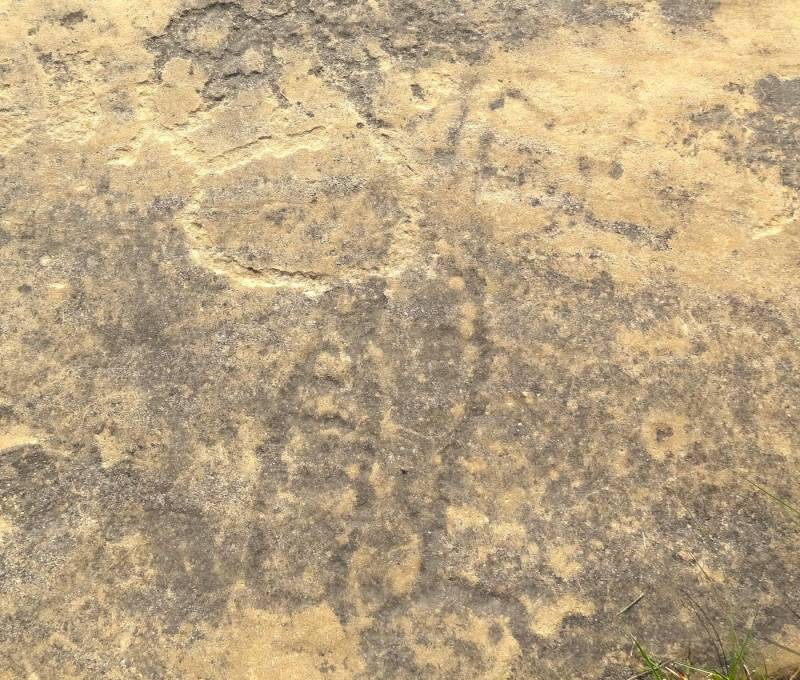
Those individual cup -marks might have been used to make paints, grind spices, or other purposes. I believe even some were used as calendars for the ancient community. Not all cupules are anthropic or man-made; some are natural features that resemble cup-marks or cupules. Researchers studying cup-marks in Pakistan should carefully examine them and learn their differences.
Besides cup-marks, the Chitter Pari rock art site features anthropomorphic, zoomorphic, and geometric motifs. Among the geometric designs, the grid pattern is quite prominent. These may represent fields or plans of some structures, secular or religious. A groove attached to one of the grid patterns probably reflects a plan of some religious structure or agricultural field with a path or waterways. The interpretation may vary, but the local topographic features should be considered while discussing images on the rock of Chitter Pari. Rectangular, square, and circular-shaped designs are observed on the boulders and merit comprehensive examination in conjunction with other motifs present on the same or different boulders. This comprehensive approach is necessary due to the inherent challenge of comprehending the visual expressions of rock art producers within the landscape. Examining motifs in isolation presents a more significant challenge. Contextualizing motifs carved in stone can impart significant meanings to the researcher.
Depictions of animals, especially goats, are also found on one of the boulders. Carvings of horseback riders have also been observed at this site. The most striking is the image of an anthropomorphic figure. This may represent a demon or a shaman.
Some other carvings include S-shaped signs, structures and the names of persons, which the residents of Chitter Pari have recently written. S-shaped signs are ancient and seem to be the tribal brands of any community in the past. S-shaped signs appear on old wooden structures in Indus Kohistan and Gilgit-Baltistan mountain communities, which I have discussed in detail in the articles written on Thor, Seo Kot, satin and Harban Valleys published in The Friday-Times-Naya Daur.
One of the boulders at Chitter Pari bears the name of Tassaduq Abbas with the date 17-7-1991 enclosed in a heart-shaped design. On this boulder are found several ancient carvings. Most noticeable are two tower-like structures representing Buddhist stupas or temples. It is quite likely these are the images of Buddhist stupas. Such tower-like stupas have been reported in Gilgit-Baltistan, KP, Balochistan, and Sindh. I have seen similar stupa images in Punjab’s Chiniot. The discovery of Buddhist images at Chitter Pari reflects that the Buddhist community was once living in the area. Apart from rock art, I observed a few cairns showing that Chitter Pari was not only the centre of rock art producers but also megalithic builders. More exploration is needed to study the rock art and megalithic landscapes of Chitter Pari village and beyond.

